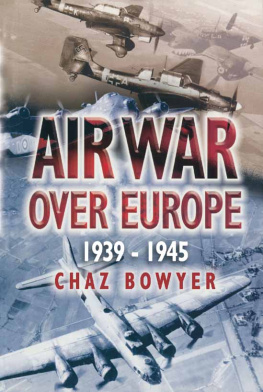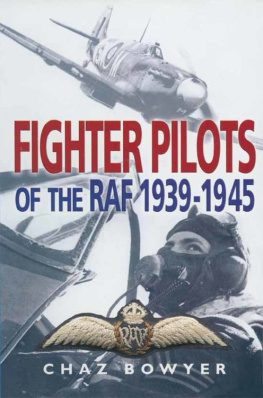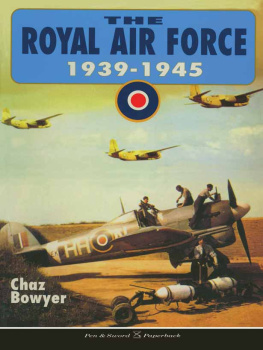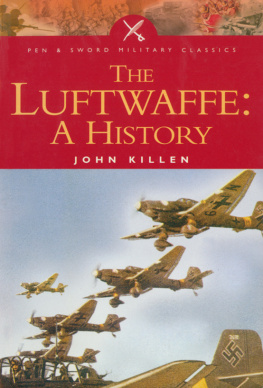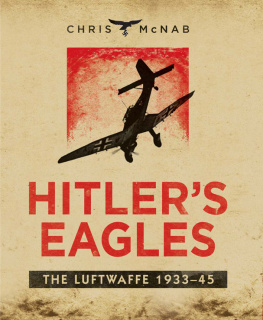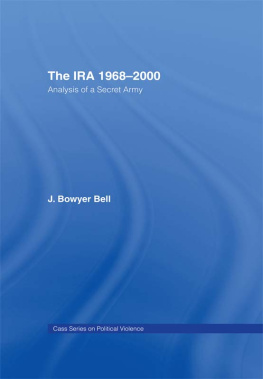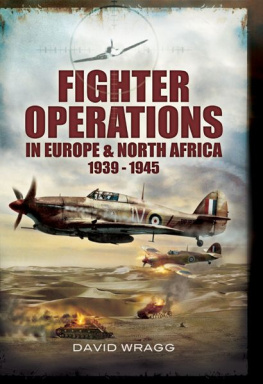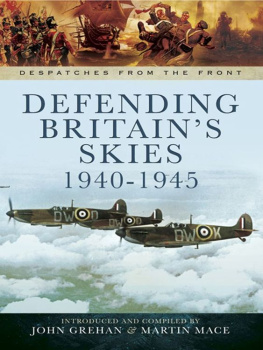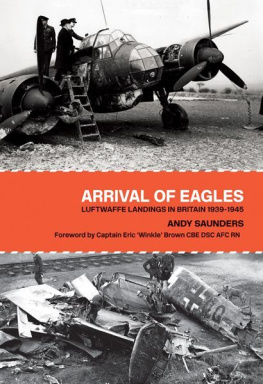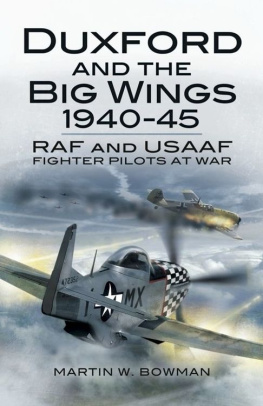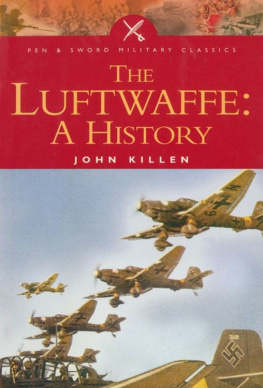AIR WAR OVER EUROPE
By the same Author:
CALSHOT, 191361
THE FLYING ELEPHANTS
MOSQUITO AT WAR
HURRICANE AT WAR
AIRMEN OF WORLD WAR ONE
SUNDERLAND AT WAR
HAMPDEN SPECIAL
BEAUFIGHTER AT WAR
PATH FINDERS AT WAR
ALBERT BALL, VC
FOR VALOUR THE AIR VCS
SOPWITH CAMEL KING OF COMBAT
HISTORY OF THE RAF, 191277
GUNS IN THE SKY THE AIR GUNNERS
COASTAL COMMAND AT WAR
FIGHTER COMMAND, 193668
SPITFIRE
VETERAN AIRCRAFT OF WORLD WAR TWO
BOMBER GROUP AT WAR
AGE OF THE BIPLANE
DESERT AIR FORCE AT WAR (CO-AUTHOR)
Edited:
BOMBER PILOT, 191618
FIGHTER PILOT ON THE WESTERN FRONT
WINGS OVER THE SOMME
THE FALL OF AN EAGLE
AIR WAR
OVER EUROPE
1939 1945
CHAZ BOWYER
First published in 1981 by William Kimber & Co. Ltd.
Published in this format, 2003, by
Leo Cooper
an imprint of
Pen & Sword Books Limited
47 Church Street
Barnsley
South Yorkshire
S70 2AS
Chaz Bowyer, 1981, 2003
ISBN 0 85052 937 9
A CIP catalogue record of this book is available from
the British Library
Printed in England by
CPI UK
Contents
List of Illustrations
PLZ P.IIs of NO 122 Squadron of the Polish Air Force.
The notorious Junkers JU 87 Stuka dive-bomber.
A Ratte of Messerschmitt Bf 109Bs.
Amiot 143 bombers of the Arme de LAir in early 1940.
Morane-Saulnier MS 406 fighters.
Hawker Hurricanes of the Belgian Air Force, at Schaffen-Diest airfield.
Fairey Battle L5540, JN-C, of 150 Squadron RAF.
Messerschmitt Bf 110 flying along the English Coast in 1940.
Spitfire of 602 Squadron being re-armed for combat.
Air Chief Marshal Sir Hugh Dowding the architect of the RAFs victory in 1940.
The Vickers Wellington or Wimpy as it was dubbed.
Pilots of No 85 Squadron RAF, in early 1941.
North American B-25C Mitchell (FV985) of 98 Squadron RAF.
Short Stirling.
A Handley Page Halifax during a daylight raid at Wanne-Eickel.
The twin-engined Manchester, precursor of the Avro Lancaster, which saw operational service from 194142.
Avro Lancaster NG347, QB-P, Princess Pat.
Air Chief Marshal Sir Arthur Harris who commanded RAF Bomber Command from 194245.
A Lancaster over Germany gets a direct hit by flak.
How some came back. Lancaster C-Charlie of No 101 Squadron RAF which crash-landed at Ludford Magna airfield.
Focke Wulf Fw 190A-4 of II/JG2 at dispersal.
Lieutenant Joseph Sepp Wurmheller, Staffelkapitn of 9/JG2 and his Focke Wulf Fw 190.
Adolf Galland with other Luftwaffe Experten fighter pilots.
Boeing B-17G Fortress of the 524th BS, 379th BG, 1st Air Division USAAF, based at Kimbolton in 1944.
Consolidated B-24J-145-CO Liberator based at Hethell in late 1943early 1944.
Little Friend. Republic P-47C-5 Thunderbolt at Kingscliffe in 1943.
North American P-51D and P-51Bs the Magnificent Mustangs.
Box bombing over Germany in 1943.
Precision bombing over the Focke Wulf aircraft assembly plant in 1943.
Victim. B-24H Liberator, little Warrior gets flak in its fuel tank over Quakenbrck.
Battle souvenir. A cheerful Bf 109G-5 pilot with a souvenir.
Two Ton-Up Lancasters.
An ammunition depot receives the attention of Halifaxes and Lancasters.
Beaufighters of 236 Squadron, RAF Coastal Command, with full complements of 3-inch rockets.
Nachtjger Messerschmitt Bf 110G-4b/R3.
Four German night fighters with the Luftwaffe commander-in-chief Hermann Gring.
Dornier Do 217 J-2 nightfighter of 4/NJG3, based at Svlt, in October 1943.
Air Chief Marshal Sir Arthur Tedder, supreme air commander of the Allied air forces.
Loading a Typhoon of No 247 Squadron RAF with 3-inch rockets.
The scene at Pforzheim on the night of 23/24 February 1945.
The notorious target of the Dortmund-Ems canal, a constant objective for the RAF.
Some of the USAAFs highest-scoring fighter aces, 56th FG, 1944.
Black Nan, a B-24L Liberator receives a direct hit over Northern Italy.
Messerschmitt Me 262A-1a Schwalbe (Swallow) twin-jet fighter.
Messerschmitt Me 163 Komet was a rocket propelled fighter designed to intercept the Allied bomber formations.
Heinkel He 162 Volksjager (Peoples Fighter) twin-jet fighter.
Heligoland Bight under bombardment by a Lancaster force on 18 April 1945, viewed from 19,000 feet.
A Mosquito A-Apple of No 143 Squadron strafing targets at Sandefiord, Norway.
Mercy Bomber. Eighth Air Force dropping food supplies to Dutch civilians.
There is many a boy here today
who looks on war as all glory
but, boys, it is all Hell.
General Sherman, 1880
Columbus, Ohio
The world war of 193945 is now almost sixty years in the past, yet many of its lessons are already forgotten; just as the lessons to be derived from that even bloodier war of 191418 were apparently lost upon the mentalities of the worlds elder statesmen during the brief respite between those two global cataclysms. In particular, the aerial warfare of 191418 the worlds first conflict in the clouds provided an ominous pointer to the future potential of air power; while the infinitely grimmer air war of World War Two put a seal on the awesome effect of death and devastation from the skies. The crucial need for establishing and wielding the weapon of air power was proven in undeniable form throughout 193945, and those relatively few prophets of the future domination of the air as the key to ultimate supremacy in war were wholly vindicated in fearful manner by the spring of 1945.
In this book I have attempted to trace the broad pattern of the use and effect of air power during 193945 over the European theatre of war alone, though patently this was but one portion of the overall aerial conflict of those years. In the Mediterranean and Far East operational zones, air power proved equally decisive in forging ultimate victory and, if only indirectly, contributed to the European struggle. Within the European parameters of my text three main air services dominated the air war: the Royal Air Force and its integrated Commonwealth partners, the American air forces based in Britain, and the German Luftwaffe. Thus my account concentrates primarily upon these giant warrior forces. In doing so it is by no means implied that other air services engaged in the war were of no importance, or that their efforts and sacrifices were in vain. Nevertheless, the duel between the two major Allied forces and the Luftwaffe was the crucial factor. Inevitably perhaps, to proscribe such a vast subject in a single volume forces the omission of a myriad of events and subjects which played small but vital roles, and such will be most evident in this account. Instead, the following pages are intended to offer a wide, general chronology and description of the air war; a skeletal framework to which may be appended the flesh and sinews of details and data. Those readers seeking in-depth knowledge of specific aspects and events omitted or merely mentioned in passing herein are commended to the select bibliography provided at the end of my text.
War was once defined by a complacent statesman as The ultimate means of a community to impose its will upon others; a view which merely reflects the utter failure of the worlds politicians to achieve permanent harmony between nations by reasoned debate or diplomatic entente. It should be borne in mind that it is the politician who creates and declares a state of war,

